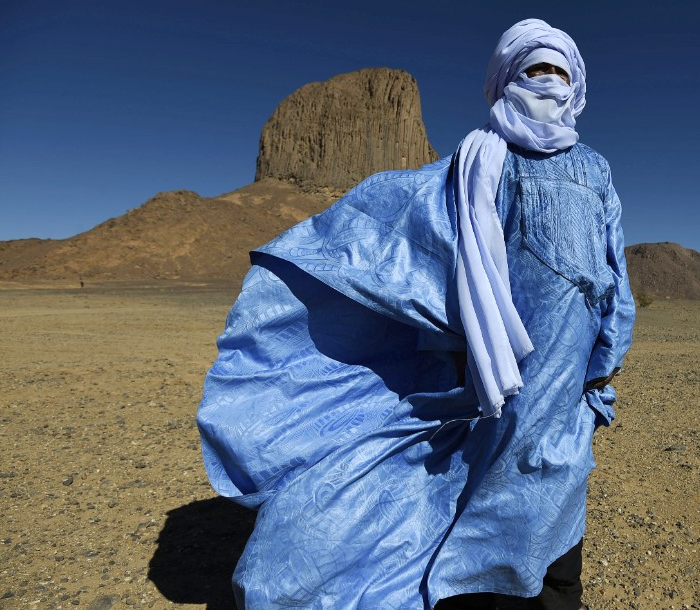Blue Men of North African origins of clothing date back hundreds of years, to the 7th and 8th centuries, in the early days of trans-Saharan trade between sub-Saharan Africa and North Africa. And while some locals will say the garment symbolizes people’s shyness and modesty, most agree that its basic function is to protect against the sun, as well as the region’s frequent sandstorms.
“The shape and style of our Daraa not only allows for proper air circulation in these harsh environments but also helps Sahrawi men conserve body water in the middle of the desert,” said locals
Today, with more people moving to the big cities and fashion styles tending towards those of the West, the attire Sahrawi men once wore to cross the hot desert has largely become a relic of the past. Yet in Morocco, where most men wear Daraa and Shash t in captivating shades of blue, it’s still alive – and it looks like it’s here to stay for a while.
Who are they?
Called bedouin or Sahrawi nomads, the blue men are the inhabitants of the central Sahara. The name “blue man” comes from the color of their scarf. Blue men often wear a long garment and a scarf about 4-5m long wrapped around the head for protection from the sun, wind, rain, sand, and cold.

Distributed in confederation or tribe, the blue men are present in 5 African countries.
In Morocco, the blue men once controlled the caravan trade between Morocco and Niger. In recent decades more and more nomads have settled down in oases, where they carry out agricultural work.
In Morocco, blue men in Morocco speak Arabic.
In the Moroccan Sahara, the nomadic populations of the desert occupy a significant place in the Moroccan political stakes. As the nomads have moved and restructured, it is difficult today to give them a real ethnic identity.
Read More: Sahara Desert
Blue men and tourism?
Saharan tourism has taken an unprecedented boom in recent decades.
. Like any trip, stays in the desert are only accessible accompanied, in a small group, on foot or by 4×4. Trips to the desert are generally initiatory, where the human aspect plays a primordial role.
Travel agencies have flourished in cities bordering the Sahara, from Morocco to Algeria via Niger. Political events in African countries, however, strongly attracted tourists to Morocco.
In the south of Morocco, from Ouarzazate to the Algerian border, the Moroccan Sahara is a source of envy.
The multiplication of national and international tourist agencies organize hikes in the desert pretending to be authentic and local. However, on closer inspection, we notice that many guides do not come from the desert. Having learned geology and languages on school benches, they have little experience in the desert.
The blue men of Sahara Culture and Tradition
► THE KAIMA
The first element of the nomad lifestyle (tent in black goat hair and camel), is the habitat par excellence of the Bedouin. After mowing the annual livestock by shepherds, the hair is cleaned by women that remove the thorns and twigs: Tcha’chi ‘. Spinning then transforms into flexible stubble son wound balls: Takbab. The loom comes into play, women come together regularly at festive assemblies for sewing flijs. The traditional tent offers a luxurious living environment, cool and relaxing. It is open permanently on the vastness of the desert, offering the possibility to admire the landscapes of sight Sahara
► DERAA
(male clothing) consists of four main parts: – a long flowing robe, Deraa – the pants, serial – the turban lithium – and light sandals, do aïl. La Deraa, white or blue, is a long dress with large assembly seams and decorations, folded and bent shoulders.
The melhfa (female attire) is. It has evolved draped with grace since nila (indigo) to the original silky and shimmering fabrics today.).
►The TEA
is an essential ritual whose preparation can occur at any time of day. On a bitter or sweet taste, it is a marker of hospitality. It is a friendly element around which the latest information is exchanged. The tea ceremony can last over an hour! A time to deepen any discussion whether domestic or societal in nature.
►THE DROMEDARY
The dromedary is known for his patience and endurance; it has always mitigated the suffering of pastoralists and facilitated their integration in difficult to arid and semi-arid environments. It carries women, children, and goods over long distances in search of pasture and water points. Two other reasons for the prominent place occupied by the camel in nomadic culture: camel milk was originally the only source of calcium and fat; its meat was the sole protein intake.
►THE HORSE
a sign of social distinction among nomads. It plays the same role as the camel and exalts and physical qualities and abilities of a warrior tribe. The horsemen, dressed in their blue or white and black chèches Deraa, armed with handmade guns, offer the best of themselves to curry favor with the tribes and ululating women. The tribe is deserving one who submits the best horses and has been synchronizing powder bursts during competitions
Take one of our nomad lifestyles trekking to the desert and learn and immerse yourself in their culture.
► And DesertBrise Travel in all of this …
Far from the bustle of Marrakech and the fierce competition, in M’hamid, life is smoother and more peaceful. Many nomads have settled down and now work in tourism.
Khalil, Abdo, and Ahmed are all nomads who have settled in M’hamid for almost a decade. Having never attended school benches, it was through contact with travelers that they learned to adapt to others in order to offer stays in the authentic desert.
Read More: Morocco’s sustainable tourism cultural traditions

